About
Special News
Logan's Page
Jacoby's Page
Our Travel Index
Tracks Ahead Related Trips
Contact
German Narrow Gauge - 2010
Originally written for the Tracks Ahead Website.

|
David Visits Wolfgang and Andreas, shooting multiple iconic narrow gauge lines. |
October 25
We left Chicago mid afternoon on a Lufthansa 747. Even though we had our usual cattle car class of seating, Lufthansa's service was great. I had forgotten that foreign air carriers offer better amenities and service than their US counterparts - at least in economy. I do think Lufthansa fixed it so the seats won’t recline as far, which was both a blessing and a curse. So it was a short night, as we lost a day on the ride over.
We picked
up our rental van about 7 AM, only to get stuck in Frankfurt traffic due
to road construction. It was a four hour drive to
 the
Harz Mountains, which are the highest mountains in northern Germany and
an inspiration for Goethe, Hesse and other German literary greats.
The fall colors are just starting so things should be pretty.
the
Harz Mountains, which are the highest mountains in northern Germany and
an inspiration for Goethe, Hesse and other German literary greats.
The fall colors are just starting so things should be pretty.
Located in what was former East Germany, Wernigerode is a charming, prosperous town.

And we are right across the street from the Harz Schmalspur Bahnen: the Harz Narrow Gauge Railway. There are three lines here, about 140 kilometers in all. While the line is primarily know for its narrow gauge steam tank locomotives, they also have a full compliment of diesel and railcars as well. The Brocken line is all steam tank locos, some little tank mallets, and period coaches. We met with the staff and our handler, and will start shooting Wednesday.
October 26
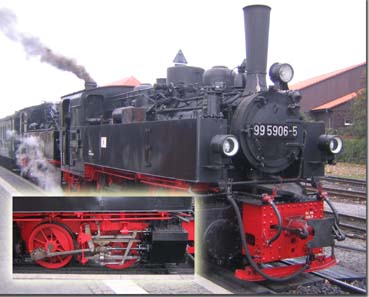 We
started the day with interviews around the yards here in Wernigerode.
The day is a bit chilly, but we were to later find that this weather was
pretty mild. We watched some of the 2-10-2 tank locos move about
and some of the daily trains depart. There was a special train
today – a double header consist with mallet type engines made in 1897.
These are the oldest engines on the line; the others were built in the
early 1950s. Interestingly, these engines were made for the
Deutsche Reichsbahn (East German Railway). There were 20
constructed, with three going to some Russian narrow gauge line.
The 17 destined for the Harz are still operational; the three that went
to Russia have disappeared, never to be seen again. No one knows
what happened to them.
We
started the day with interviews around the yards here in Wernigerode.
The day is a bit chilly, but we were to later find that this weather was
pretty mild. We watched some of the 2-10-2 tank locos move about
and some of the daily trains depart. There was a special train
today – a double header consist with mallet type engines made in 1897.
These are the oldest engines on the line; the others were built in the
early 1950s. Interestingly, these engines were made for the
Deutsche Reichsbahn (East German Railway). There were 20
constructed, with three going to some Russian narrow gauge line.
The 17 destined for the Harz are still operational; the three that went
to Russia have disappeared, never to be seen again. No one knows
what happened to them.

We chased the train to Schierke Station, where we got on for the ride up to the summit of the Brocken. It is easy to see that the dense forests and tumbled rocks of the mountain would give rise to many legends and myths. In fact, the restaurant at Schierke Station is the Hexenbaude (Witch’s Lair).
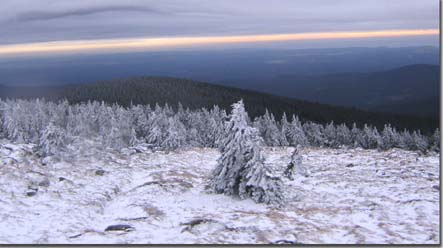
The summit of
the Brocken was – in a word – freezing. None of us were quite
prepared for this. While it was a mild day, there was snow, and
ice, and freezing rain. At 1142 meters (around 4200 ft) this is
the highest point in northern Germany. The Russians built a radar
station and radio traffic listening post here
during the Cold War. It is now a museum. We hung around for
an hour or so, and then took the next train down. The area was pretty,
with Christmas postcard show covered trees, etc. But it was windy
and cold. We were told that on some days, the wind is so strong
that it rocks the train and will blow the windows open if they aren’t
latched. Think of it a Germany’s Mt.
Washington.
or so, and then took the next train down. The area was pretty,
with Christmas postcard show covered trees, etc. But it was windy
and cold. We were told that on some days, the wind is so strong
that it rocks the train and will blow the windows open if they aren’t
latched. Think of it a Germany’s Mt.
Washington.

We continued to shoot a bit around Schierke Station, and then got a few more passes down the mountain. The trains are quite picturesque, and the consists move right along.
 We
got back to the hotel to triage the video. We are all still a bit
jet lagged. This really is a rail fans paradise. There is
plenty of action – up to ten trains a day. They are relatively
fast, and are almost all steam. There are plenty of places to
watch the trains, you have shop access, and a person can sign up for cab
rides and operational sessions. What’s not to like?
We
got back to the hotel to triage the video. We are all still a bit
jet lagged. This really is a rail fans paradise. There is
plenty of action – up to ten trains a day. They are relatively
fast, and are almost all steam. There are plenty of places to
watch the trains, you have shop access, and a person can sign up for cab
rides and operational sessions. What’s not to like?

The town is lovely, and there are plenty of restaurants and hotels from which to choose. In fact, in our hotel restaurant, the drinks are delivered by an LGB tank loco and two flatcars. Like I said, what’s not to like?
October 27
There is nothing quite like watching a tank locomotive do a water fill early in the morning. Well, maybe you have to be a railroad fan to really like this. Today we worked the line that runs through the Selke River Valley. The Selke is the longest of the rivers flowing out of the Harz Mountains.
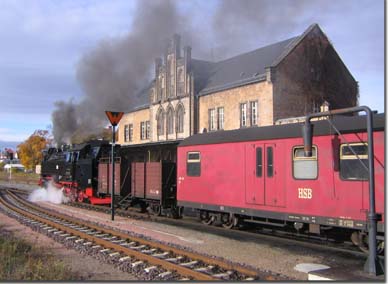 The
line basically runs from Quedlinburg to Hasselfelde, although there is a
cut off at Steige that takes it to Eisfelder Talmuhle, where the line
continues on the Nordhauser. Some of the Selke Valley line is
relatively new, as the original was torn up in 1949 by the Russians for
war reparations. It did not get rebuilt until the 1980s.
This line runs through a lot of hardwood forest, on steep grades and
tight turns. Eventually the line opens up into rolling meadows, so
passengers get a nice look at a variety of
The
line basically runs from Quedlinburg to Hasselfelde, although there is a
cut off at Steige that takes it to Eisfelder Talmuhle, where the line
continues on the Nordhauser. Some of the Selke Valley line is
relatively new, as the original was torn up in 1949 by the Russians for
war reparations. It did not get rebuilt until the 1980s.
This line runs through a lot of hardwood forest, on steep grades and
tight turns. Eventually the line opens up into rolling meadows, so
passengers get a nice look at a variety of terrain, in addition to many picturesque towns.
terrain, in addition to many picturesque towns.
The station at Quedlinburg is the oldest on the line, and has the look of a cathedral. We chased the train through forest and glen, and then ended up at the end of the line in Hasselfeld, where there was a small museum.
 I
could not resist the winged wheel. I have seen this image – in
some form – in Egypt, New Zealand, Turkey, Denmark, Russia, and other
places that escape me. It certainly speaks to the whole concept of
the railroad.
I
could not resist the winged wheel. I have seen this image – in
some form – in Egypt, New Zealand, Turkey, Denmark, Russia, and other
places that escape me. It certainly speaks to the whole concept of
the railroad.
As we
left, we did a big valley shot, and the ended our train chase with a great shot of it on its way around a tight mountain curve
to Nordhausen. From there it was a drive back into Wernigerode,
where we shot some of the downtown. I must say that this place is
a lot better appearing than I had expected for a former East German
town. There is obviously a great deal of tourist traffic and there
is plenty to do and see – in addition to the railway. Our handler
today was a still photographer, Olaf Haensch. He is working on a
book for his company that is all about night photographs of the Hsb.
chase with a great shot of it on its way around a tight mountain curve
to Nordhausen. From there it was a drive back into Wernigerode,
where we shot some of the downtown. I must say that this place is
a lot better appearing than I had expected for a former East German
town. There is obviously a great deal of tourist traffic and there
is plenty to do and see – in addition to the railway. Our handler
today was a still photographer, Olaf Haensch. He is working on a
book for his company that is all about night photographs of the Hsb.
You can
see a bit of a preview at
www.nachtzuege.com. Unfortunately for Americans, it is all in
German, but the spectacular photos
 will
translate into any language. Check it out. (Note: The
book arrived around Christmas time, and is a wonderful as promised.)
will
translate into any language. Check it out. (Note: The
book arrived around Christmas time, and is a wonderful as promised.)
Tomorrow we will shoot the shops, and plan to take the train from Wernigerode to Drei Annen Hohne again to compensate for some missed footage from yesterday.
But for the rest of the day, it was a chance to walk around Wernigerode a bit, see the old courthouse, and just explore the busy downtown.
October 28
We started the day by shooting in the shops, which were clean and neat and with lots of people at work.
 Note
that the diesels here at the Harz look quite large. As with all
things, there is a reason for this. They were originally built for
standard gauge, but the railroad put narrow gauge trucks under them.
Note
that the diesels here at the Harz look quite large. As with all
things, there is a reason for this. They were originally built for
standard gauge, but the railroad put narrow gauge trucks under them.
 We
shot some passes at the shop station, then went up to Kirchstrasse
(Church Street) for street running. The crew went on the train to
Drei Annen Hohne for some cab footage. What followed was a long,
tough drive to Zittau with heavy, heavy traffic and lots of trucks.
We
shot some passes at the shop station, then went up to Kirchstrasse
(Church Street) for street running. The crew went on the train to
Drei Annen Hohne for some cab footage. What followed was a long,
tough drive to Zittau with heavy, heavy traffic and lots of trucks.
We had hooked up with my friend Wolfgang last night, so we had a continuing guide for our trip.
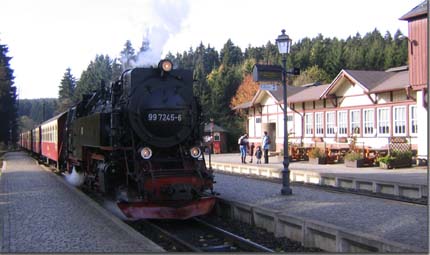
Unfortunately, his GPS was older so it took a long time to get here, as it didn’t have updated maps (as we found out later). We crashed at our rest stop for the next several nights, which is an old station, now a B&B. A simple dinner, was followed by bed. It is to dark to see anything. Tomorrow we start to examine three lines in the German state of Sachsen. View rough Harz segment here
October 29
Welcome
to Sachsen, or as the Americans would call it, “Saxony.” Our trip
today started in Jonsdorf, which is quite close to Zittau. The area is
in a small eastern pocket of Germany, which is closely bordered by
Poland and the Czech Republic. Here we found a series of narrow
gauge lines, all 750mm lines.
started in Jonsdorf, which is quite close to Zittau. The area is
in a small eastern pocket of Germany, which is closely bordered by
Poland and the Czech Republic. Here we found a series of narrow
gauge lines, all 750mm lines.
 Running
on the SEG Line was a special train, a reconstruction of an original
Saxony train, with a tank locomotive, two fourth class, one third class,
and a baggage car. These engines may be distinguished, by the
rather low profile, and the low water tanks. Another feature is
the rope system running along the roof of the cars, which can barely be
seen in the photo. This was for a manual brake system. The
line runs from Zittau to Bertsdorf, and then the trains sort of see-saw
between the neighboring areas of Jonsdorf and Oybin.
Running
on the SEG Line was a special train, a reconstruction of an original
Saxony train, with a tank locomotive, two fourth class, one third class,
and a baggage car. These engines may be distinguished, by the
rather low profile, and the low water tanks. Another feature is
the rope system running along the roof of the cars, which can barely be
seen in the photo. This was for a manual brake system. The
line runs from Zittau to Bertsdorf, and then the trains sort of see-saw
between the neighboring areas of Jonsdorf and Oybin.

As this graphics on this boxcar will attest, this was all part of the former East German Republic.
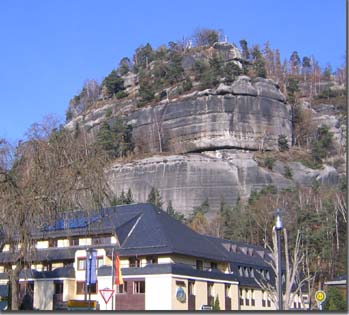 These
towns are all in the Zittau Mountains, the lowest mountain range in
Germany. So we worked our way from the Harz (the highest range) to
here. We shot from Zittau to Oybin, which is a bit of a resort
area. One of the outstanding features is the rock face which looms
over the town. The hotel was a favorite of the East German
politicians. My friend said it was done up in "modern, East
German" style, which meant lots of plastic; beds, chairs, wall fixtures,
all plastic. This from the country that brought us the Trabant.
These
towns are all in the Zittau Mountains, the lowest mountain range in
Germany. So we worked our way from the Harz (the highest range) to
here. We shot from Zittau to Oybin, which is a bit of a resort
area. One of the outstanding features is the rock face which looms
over the town. The hotel was a favorite of the East German
politicians. My friend said it was done up in "modern, East
German" style, which meant lots of plastic; beds, chairs, wall fixtures,
all plastic. This from the country that brought us the Trabant.

The railroad also runs a 2-10-2 tank locomotive, as well as a streetcar. The whole operation has been restored to a period look, with the state of Sachsen recognizing that these lines are an important part of their heritage. And they bring in a lot of tourist dollars as well. Ridership in the last 5 years has increased 145%. So the sate and the cities pump money into the lines. Hear that, United States?
 We
worked the multiple stops, including a double steam pull out at
Bertsdorf. The day finished back in Zittau with city shots.
Much of the town has been rebuilt, but because he industrial base was so
outdated once reunification occurred, the population has dropped from
45,000 to roughly half that. On the plus side, real estate is pretty
inexpensive.
We
worked the multiple stops, including a double steam pull out at
Bertsdorf. The day finished back in Zittau with city shots.
Much of the town has been rebuilt, but because he industrial base was so
outdated once reunification occurred, the population has dropped from
45,000 to roughly half that. On the plus side, real estate is pretty
inexpensive.

I should again mention our lodgings. The Jonsdorf station is owned by the president of the railroad. His wife runs a B&B here, right next to the rails. It is quite nice and a definite stop for travelers to the area. After all, all the trains stop right outside your window.
Tomorrow we will continue on our look at the Saxony Steam Railway Network.
October 30
 We
departed our station hotel this morning and headed for Radebeul.
However, it seemed that all the roads heading that way were under
construction. We finally managed to et enough info off the GPS to
make our way, but sometimes I think printed maps are best. We
arrived at the Saxony Narrow Gauge Museum in Radebeul only to find that
our contact wasn’t coming until 2 PM. So we shot some of the
museum’s exterior collection. Of note is this standard gauge coil
car. It seems the east German government was bent on tearing up
all the narrow gauge lines. One line in particular was slated to
go. However, it served a factory making modern refrigerators.
The materials were being shipped by standard gauge but the terrain to
the factory was such that they needed the narrow gauge to go the final
We
departed our station hotel this morning and headed for Radebeul.
However, it seemed that all the roads heading that way were under
construction. We finally managed to et enough info off the GPS to
make our way, but sometimes I think printed maps are best. We
arrived at the Saxony Narrow Gauge Museum in Radebeul only to find that
our contact wasn’t coming until 2 PM. So we shot some of the
museum’s exterior collection. Of note is this standard gauge coil
car. It seems the east German government was bent on tearing up
all the narrow gauge lines. One line in particular was slated to
go. However, it served a factory making modern refrigerators.
The materials were being shipped by standard gauge but the terrain to
the factory was such that they needed the narrow gauge to go the final mile. So rather than transload, they loaded the entire coil car on
a narrow gauge car transporter.
mile. So rather than transload, they loaded the entire coil car on
a narrow gauge car transporter.
Once we left the museum, we went over to Moritzburg, did an interview with the marketing director from the Lößnitzdackel and Weissertalbahn Railways.

Moritzburg has a fine, restored castle, and the traffic was intense. What were all these people doing here? We never did find out.

We did some train passes, including a street crossing where a modern trolley had to wait for the steam train.
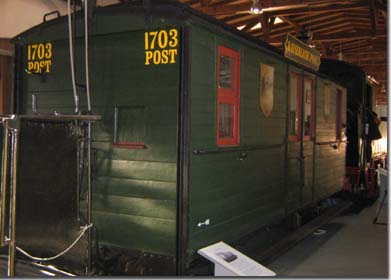 Then
it was back to museum for an interview with the museum director, and the
shots of the interior, including this 1897 RPO. Finally the day
ended at Rabenau with the meeting of a steam train and a modern S-Bahn
unit. We are in the Rabenau Grund (Gorge) with the train passing
right past our hotel. It is quite lovely.
Then
it was back to museum for an interview with the museum director, and the
shots of the interior, including this 1897 RPO. Finally the day
ended at Rabenau with the meeting of a steam train and a modern S-Bahn
unit. We are in the Rabenau Grund (Gorge) with the train passing
right past our hotel. It is quite lovely.
October 31
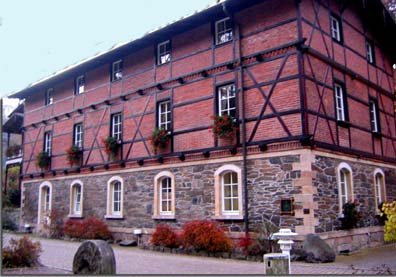 Our
hotel is the Rabenauer Muhle, which is translated as Rabenauer Mill.
It is a lovely place with a great restaurant, bar, and rooms. Our
hosts bought the place from the East Germans around the time of the
reunification (late 1980's) and have built it up to a hidden gem here in
the valley.
Our
hotel is the Rabenauer Muhle, which is translated as Rabenauer Mill.
It is a lovely place with a great restaurant, bar, and rooms. Our
hosts bought the place from the East Germans around the time of the
reunification (late 1980's) and have built it up to a hidden gem here in
the valley.
We were up early this morning and
down into the gorge in the early
 morning
mist. The train rolled past right on schedule. That is one thing:
the trains are on time.
morning
mist. The train rolled past right on schedule. That is one thing:
the trains are on time.
We did a couple more passes during the next two hours, and finished with a gorgeous shot along the creek. At that point it was time to say goodbye to Wolfgang, and head on our separate ways – he south, and us north.
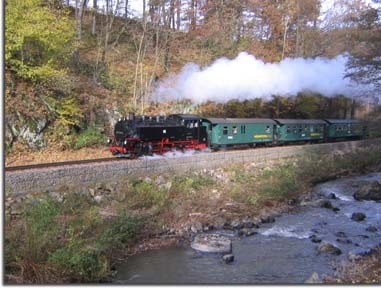
As it was mostly autobahn driving, we arrived in Kuhlunsborn, right on the Baltic Sea about 3:30, just as the GPS said we would. Another of my friends and veteran of several Tracks Ahead trips, Andreas Stirl, met us at the hotel. We had a beer or two and caught up on adventures since our last meeting. View rough Saxony Rwy segment here
Tomorrow we start the Molli Bahn, a narrow gauge very close to the US narrow gauge standard. The weather does not look promising.
November 1
 Today
was damp, windy, and very chilly. Fortunately, the rain held off,
so we rushed to get as many exterior shots as we could. I wish I
could say it will be beautiful, but everything was just sort of grey and
flat today. There was so much moisture in the air that color just
washed out. We started with a short interview with the sales and
marketing director of the Mecklenburgische Baderbahn Molli – otherwise
known as the MolliBahn.
Today
was damp, windy, and very chilly. Fortunately, the rain held off,
so we rushed to get as many exterior shots as we could. I wish I
could say it will be beautiful, but everything was just sort of grey and
flat today. There was so much moisture in the air that color just
washed out. We started with a short interview with the sales and
marketing director of the Mecklenburgische Baderbahn Molli – otherwise
known as the MolliBahn.

This line, which is operated by the bus company, offers regular daily steam service between Bad Doberan, through Heilengendamm, to the seaside resort of Kuhlungsborn. The line is 900mm, which translates to ½ inch less than the US narrow gauge of 36 inches. So the engines and cars are larger than what we have been seeing in the previous days. Kuhlungsborn is the main sea resort for Germany, and has hotel after hotel facing the Baltic.

Half way in between is Heilengendamm, site of a Kempinski Hotel, where the G8 Summit was held a few years ago. It is a very exclusive area, so you have to a guest to get close to the place.

These villas, built around the turn of the 20th century, are sometimes called "The String of Pearls." People are attempting to restore some of them, most of which were used as sanitariums in East German times.

At the end of the line is Bad Doberan, where the train is noted for it’s street running. Both cars and people share with the train. We were told that in the summer months, when street bistos are popular, people just sit and dine, with the train only a meter or so away.
November 2
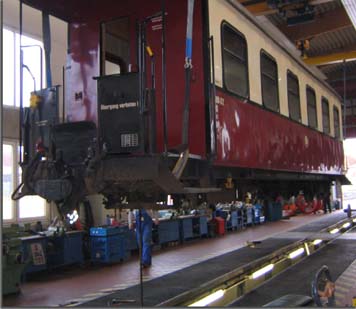 Today
it rained. Fortunately, we had planned for this, and virtually all
of our morning material was indoors. We started with a short
interview with our locomotive engineer for the day, in what was probably
one of the cleanest shops I have been in. I felt guilty tracking
up the floor! The crew went on the train, and Andreas and I did
some shots with his cameras from the car. We then did an interview
in the main shop in Bad Doberan – also very clean – and watched as the
mechanics changed out a wheel set. It seems that the railroad has
one more left turn than right, and to keep wheel wear down, they
periodically flip the axle sets around.
Today
it rained. Fortunately, we had planned for this, and virtually all
of our morning material was indoors. We started with a short
interview with our locomotive engineer for the day, in what was probably
one of the cleanest shops I have been in. I felt guilty tracking
up the floor! The crew went on the train, and Andreas and I did
some shots with his cameras from the car. We then did an interview
in the main shop in Bad Doberan – also very clean – and watched as the
mechanics changed out a wheel set. It seems that the railroad has
one more left turn than right, and to keep wheel wear down, they
periodically flip the axle sets around.
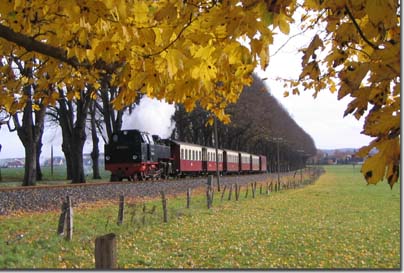
While it appeared that the sun was coming out, this turned out to be the case only long enough for us to get a pretty shot of the train puffing up a small hill outside of Bad Doberan.
And that was it. Our third segment for this trip is complete. View rough Mollibahn segment here.
November 3
Our day today was relatively uneventful which was fine with me. All we did was have a seven hour drive down a crowded series of autobahns to our hotel outside of Frankfurt. It rained most of the way, and was extremely windy. Traffic on the road held pretty much to the speed limit of 130kph (around 80 mph) and we only got blown away by a pair of Audi A8's which had to have been running at 200/220. Note to American drivers. Take a lesson from here. You DO NOT stay in the left lane except to pass. And that maneuver is done quickly.
November 4
We were up early and out for our adventure of trying to return the rental van in the dark early morning hours. I got turned around once, but our GPS again performed admirably. The airport was a zoo, but we got on the flight with no difficulties. My seatmate was a pilot for a global air freight carrier, and proved to be a delightful companion for the next nine hours. So as I previously said, we have only the transitions, and the Russian trip before the eighth season is complete.